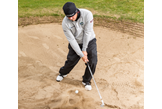Secrets of the Tour Stat Leaders
Published: Last updated:
What you can learn from the European Tour’s best drivers, green-hitters, scramblers and putters
Stats play an increasingly important role in the world of a professional golfer. They reveal what players are good at, what they’re bad at, how they compare to the eld and – crucially – areas they can improve. Former US Open champion Graeme McDowell told us:
“My caddie fills in a pretty extensive sheet after every round with every club and every yardage where we missed it, where the wind was, what the conditions were etc. We’ll get a good selection of stats together over three or four months and then we’ll sit down and find out what we’re trending and where the weaknesses are. Then it’s all about using the numbers e effectively and being sensible about what you want to find out.”
Stats also reveal who’s best at what on Tour – distance, hitting greens, hitting fairways, getting up and down, bunkers, putting… Over the next six pages, you’ll find exclusive advice from some of the men at, or very near, the top of these categories. They’ll reveal how they’ve become so skilled in one particular part of the game, before revealing what you can do to improve your own success rates.
Putting: Paul Dunne
Stat Attack: Average Putts 28.1 (1st), Putts per GIR 1.7 (1st), One putts per round 6.04 (1st)
2017 highlights: Won British Masters and runner-up in Trophee Hassan II
His putter: Scotty Cameron GoLo S2 (centre-shafted)
I’ve always been a good putter, and this year has been a special year. I’ve holed out well and made my fair share of mid-range birdie putts. But I’ve been working hard on it and it’s something that’s improved over the years. The basics are to make sure the putter is feeling comfortable in my hands – that’s the most important thing – and my forearms are relaxed; my posture needs to be consistent and my alignment needs to be good. Those things are easy to practice. They’re the basics and I try and practise them until I feel comfortable and once I feel comfortable, all I think about is the speed.
Strike is so important and if you’re striking it consistently, you’re speed is going to be good. And once you get dialled in with your speed you just don’t think about it anymore, it becomes automatic. The idea is to try and make it as reactionary as possible, like throwing keys into a bucket. But first you’ve got to make sure the fundamentals are there and once you’re con dent with those, it’s a case of doing the same things over and over. When I feel I’m set up square, that’s when I’m going to putt well. I have the same rhythm to every stroke, just changing the length of it. Generally it will be fairly short and quick and that’s just how I’ve done it naturally and I don’t envisage that changing.
How you can hole more putts:
Everyone should have one go-to putting drill – not technical, because putting isn’t technical, but say put two tees either side of your putter like a gate and work on your strike. I work with a ruler– I put my ball on that – and I do that every day. I can match up the putter alignment to the line on the ruler and I can see a straight true line and I know that my ball is starting on the right line, otherwise it will fall off.
You can also try some simple performance drills such as throwing some tees around a hole and see if you can make 36 in a row or whatever. Or throw eight to 10 in a circle and try and make them all with two or three balls. It’s good fun and meaningful practice – if you miss the last one, you’ve got to start again. You could be trying to win a tournament or just making the cut, there’s just fewer people watching.
Scrambling: Mike Lorenzo Vera
Stat Attack: 3rd (64.2%)
2017 highlights: Five top 10s including 3rd in the French Open
His clubs: Titleist Vokey SM6 (52° and 58°); Toulon San Diego putter
I have a passion for chipping, but a big thing for me is that I’m not trying to short-side myself too much with my approach shot. I’m pretty good at scrambling mainly because I have easy chip shots! With normal chip and runs from about 15-20 yards, I’m just trying to stand the shaft a bit straighter. My stance will see my feet just inside the width of my shoulders which will be aiming a bit left with the club stood a bit on the toe. Then I just drop the club and you should find the sweet spot every time – it’s just physics, and you don’t have to do anything else but just the toe bounce of the club. My speciality is downhill bunker shots, so don’t put a coin on that and bet against me. I love short-sided bunker shots down the slope – it’s like red wine for me!
How you can get down in two:
My short game has developed since I was young, probably around 10, when I worked on a really small chipping green at my local course in Biarritz. I was there at least two hours a day just loving to try to hole the ball from various lies, good and bad, opening the clubface to the maximum and understanding how it works until I got pretty good at it. Remember, your best friend is the putter, your second best is your sand wedge. Around the greens I’m always taking a 58° sand wedge – I love it. But that’s my personal preference – practice and work out what’s best for you and it’s likely it will be something with a lot less loft.
Driving Distance: Lucas Bjerregaard
Stat Attack: 3rd (309.4 yards)
2017 highlights: Won Portugal Masters and T8 in British Masters
His driver: Titleist 917 D2
Long hitting has always come naturally to me. Since I was teenager I was quite big and have always been able to create power and hit the ball a long way. It’s not something I’ve ever worked at, which is nice – you see a few guys who aren’t that big when they’re growing up and they struggle to find distance. But luckily I’ve always had it so, for me, I try and concentrate more on accuracy.
There’s no doubt it’s an advantage because I’m usually hitting shorter irons into the green. But distance is only an advantage if you can hit it straight, so in an ideal world you want a bit of both. There are a lot of courses where it’s definitely an advantage and when I hit it straight, I’m definitely set up a bit better than a lot of the other guys – it’s easier to hit it from the fairways as you’ve got more control. I tee it up quite high and I hit about 3-4 degrees up on it which gives me a high launch, low spin and lets it go forward – virtually the very opposite of many amateurs who hit 4-5 degrees down on it, meaning it’ll come out quite low with a lot of spin.
How you can bomb it:
Go and see a fitter who will fix you up with the right driver – I’m sure you’ll quickly find an extra 10-15 yards. It’s the most expensive solution, but the easiest one! You need to make sure you’re flexible enough to hit it hard as well but the big key is to hit upon the ball and don’t be afraid to hit it high – that’s how you’ll get the furthest carry. You see a lot of players that try to control it and hit down on it, trying to steer it, but tee it high, put it opposite your front foot and just hit up on it. That’s the best tip I can give. Also, if you’re looking to hit it hard, don’t grip the club too hard and try and do so straight from the address position. Remember, the most speed you want is when you actually hit the ball – the quicker you take the club back, the more energy you’ve used so you want it to be nice and smooth. Build, build, build… and then bingo!
Driving Accuracy: Wade Ormsby
Stat Attack: 3rd (67.2%)
2017 highlights: 5th in Andalucia Valderrama Masters and tied 5th in Fiji International.
His driver: Titleist 917 D2 (8.5°)
My accuracy is a bit of a by-product of not having so much power – if you don’t have a lot of power you have to be straight, so I’ve always had to hit it pretty straight to compete. I’ve never been a great ball striker, but driving accuracy is something I’ve had to do well along with chipping and putting, which I’m also quite strong at. I’ve always hit draws which I think are probably more reliable to hit off the tee because you’re hitting up on the ball, and with the technology these days and from a driving point of view, hitting up on it is more beneficial. We’ve got a lot of information these days so you know where you have to be within those windows in order to play your best. With the driver I’m looking to strike it a little bit up, a little bit from the inside and that gives me a little draw
How you can hit more fairways:
You can’t really change your D&A as a player – you’ve got to keep working at it and try to work on your weaknesses. You just play within your ability I guess and what feels comfortable to you. Some weeks you drive it better than others, and I feel most comfortable when I just draw it without trying to draw it and not trying to fight it. There’s a difference between finding every fairway and driving it really well – you can actually scatter it down there – and, for me, a combination of both is what you’re looking for.
Hitting fairways is a big part of the game and I think driving has become easier thanks to the big booming drivers, the ball and everything else. When the courses are set up tough and the tight fairways are lined by thick, tangly rough, there’s still a big emphasis on hitting fairways regardless of how long you can hit it. If, like me, you don’t have that ability you really need to do whatever it takes – and with whatever club – to find as many fairways as possible. Achieve that and you’ll not only have more control over your shots, you’ll have a better chance of scoring par or better.
Stroke Average: Graeme McDowell
Stat Attack: 4th (68.08%)
2017 highlights: Just outside top 10 in Dubai Desert Classic, Dunhill Links, Valspar Championship and Honda Classic.
His clubs: Driver: TaylorMade M1 440 (10.5°); Fairway: Srixon Z F45 17°; Hybrid: Adams Idea A7 19°; Irons: Srixon Z 745; Wedges: Cleveland 588 RTX; Putter: Odyssey White Hot #7
Scoring average is the result of a lot of different things – playing well, and hanging in there when you’re not playing well. It’s really important to keep big numbers o the card and being able to dig in when the round gets away from you. It’s been a good putting year for me and I feel like my putting is close to my best again which is exciting as that’s taken a bit of a dip over the past three or four years. I think I’m fourth in strokes gained putting in the PGA Tour stats and ninth in driving accuracy, so two of my big keys are back where I need them to be.
Now I’m working on the physical stuff to get a bit of ball speed back though I’ve resigned myself to never being able to match Dustin Johnson or Rory McIlroy. But ideally I can nd an extra 3-4mph. I’ve gone back to doing things I used to do – we’re not very good at continuing to do the things that made us good! I went back to an old mirror I used to use and set up my own little putting gate with some tees on the mirror and that’s the drill I go to. If you’re great inside ten feet and your speed is good, you can be a great putter. It’s just down to reading after that…
How you can go lower:
Firstly, you should look at your putting, especially inside 10 feet – you can analyse your putting simply by looking at your speed, how many putts you’re holing and you look at your short putt percentages. After that, distance control is one of the big keys – if you can be pin high more often than not, that’s a good sign your distance control is where it’s at. Then it’s about driving accuracy, though I’m not sure whether the old ‘drive for show, putt for dough adage’ holds up anymore. Depending on the course set-up there may be an opportunity to use your stroke and if you’re playing a tree-lined parkland course, we all know you’ve got to keep it in play.
Greens in Regulation: Graeme Storm
Stat Attack: 3rd (13.2 GIR per round)
2017 highlights: Won South African Open, beating Rory McIlroy in a play-off, and four other top 10s
His irons: TaylorMade P770 (3-PW) and Titleist Vokey SM6 wedges (52° and 58°)
I’m swinging it better than I probably ever have at the moment. I know what I’m doing, I know where I need to be, so I’m striking the ball better. I’ve always been pretty consistent hitting greens with my 3-5 irons though I might not always get it close enough at times. Plus I’ve improved with my shorter irons so I’m able to attack more pins and give myself more chances. Swinging well breeds con dence, which gives you a more aggressive outlook when playing to ags. And when you are chipping and putting nicely as well, you’ve got even more confidence so you relax a bit thinking ‘if I miss that green, I can get up and down.’ Obviously to find the green you’ve got to hit the fairways and obviously there are courses where you can get away with more wayward shots. There are times when you have to drive the ball well to be able to hit the greens – the courses themselves, especially the size of the fairways and greens, are contributory factors.
How you can hit more greens:
What I say to club golfers when I play with them in pro-ams is that you get shots, so make sure you use your shots. So if you can’t reach a par-4 in two, give yourself a chance to get it up there and give yourself a chance to pitch it within 15-20ft and have a putt for a nett birdie. Use your shot as opposed to wasting it by making a five or six. If you play o 12, use your 12 shots and you can drop your handicap to 10 quite quickly. It’s not all about smashing it down there and getting it on the green and making birdies all the time. It comes down to strategy at the end of the day and in a lot of cases, club golfers don’t use strategy. Another thing I would say to club golfers is if you’re striving to score better, look at the stat showing how many times you’ve hit the ball to within 20ft of the hole. That’s something I’m looking to improve at and so should you…
Sand Saves: George Coetzee
Stat Attack: 2nd (68.8%)
2017 highlights: Seven top 10s including T3 in KLM Open.
My wedges: Titleist Vokey SM6 (50°, 56°, 60°)
When my bunker play is bad my hands get in front of the ball at impact. A good bunker player’s hands are always behind the ball at impact with the shaft leaning back. This is because hand position relative to the clubface dictates which part of the sand wedge’s sole makes contact with the sand. When your hands are ahead it presents the sharp leading edge of the club into the sand, causing a digging, heavy contact; when your hands are correctly behind, it presents the curved trailing edge of the sole, or the bounce, to the sand, which gives a more skimming and more controllable contact. It sounds a bit technical but if your hands are behind the ball, the club bounces underneath the sand and the ball pops up.
How you can improve from sand:
Firstly, you’ve got to interpret your lie. Taking your stance is key: when you see guys waggling their feet in the bunker, it’s not for gripping, but for feeling how much sand you’ve got to play with. The old interpretation of bunker play would be to aim 45° left (right- handers) with the clubface 45° open. But the new way is to aim square to the target because it’s easier to get your hands behind the ball.
Play the ball forward in your stance and keep your weight on the lead foot throughout the swing. Keep the clubface open because once you set your hands behind the ball at address, it actually points the clubface at the target. Bunker play is an art form, but you’ve got to spend time working on it. As a kid I spent a lot of time messing around in the sand, working out what the sand and the ball does and how to play shots better from all kinds of lies. So take a bucket of balls, get in a bunker and work things out for yourself for a couple of hours – two hours once a week will drastically change your bunker game… I guarantee it.








